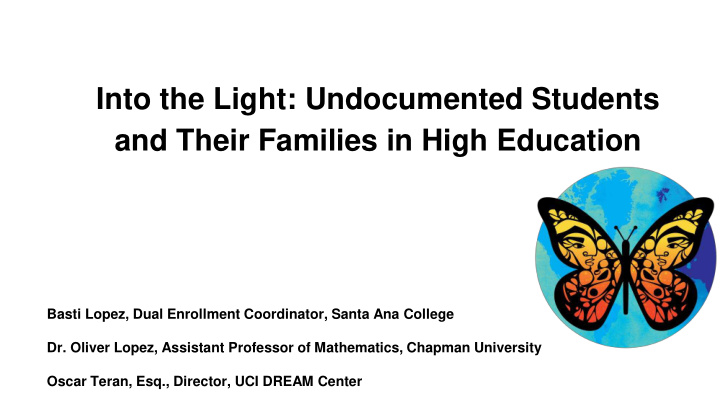



Into the Light: Undocumented Students and Their Families in High Education Basti Lopez, Dual Enrollment Coordinator, Santa Ana College Dr. Oliver Lopez, Assistant Professor of Mathematics, Chapman University Oscar Teran, Esq., Director, UCI DREAM Center
Undocu Voices Centered Please take 10 minutes to view the art hanging on the walls. Each piece was created by an undocumented immigrant student and reflects their unique experience navigating higher education. Contemplate the questions posted next to each art piece and reflect on the stories told through the art. Your facilitators are available for any questions or discussion.
Now That You Have Heard from Students . . . We invite you to learn more about the most significant challenges that impact access to higher education for undocumented students and then to formulate solutions that can help Orange County meet these challenges
OC Immigration Profile: Lessons Learned
Orange County Needs to Prioritize Access to Higher Education for Undocumented Immigrants “47.7% of Orange County’s foreign -born population in the 18 to 24 age group are currently attending college or graduate school. This is 5.5% higher than . . . the rest of the foreign-born population nationally in the 18 to 24 age group who are currently attending college or graduate school.” (OC Immigration Profile, P.22) “38.4% of the county’s labor force is foreign born.” (OC Immigration Profile, P.11) This translates to $93.7 billion of OC’s GDP and $5.9 billion annually in total income taxes.
Orange County Needs to Prioritize Access to Higher Education for Undocumented Immigrants Orange County’s immigrant population is more educated and more economically productive than other counties in California and many other parts of the country. Our communities benefit socially and economically from these contributions. Yet, undocumented immigrants face significant and unique challenges in higher education, which limits their economic mobility and the economic growth of Orange County. Unlocking the Power of All
Financial Barriers to Higher Education SOCIOECONOMIC STATUS: 40 percent of undocumented children live below the federal poverty level (compared with 17 percent of native-born children). LACK OF FINANCIAL AID: Undocumented students are not entitled to Federal financial aid of any kind. State aid and in-state tuition are available to students that meet the qualifications of AB540 but there will always be an aid gap compared to citizen peers. Since 1989 college tuition has grown at twice the rate of inflation and eight times faster than wage growth. FINANCIAL LITERACY: For first generation college students who often come from low socioeconomic status families, managing personal finances and navigating complex financial decisions associated with college are tremendous barriers.
Internalized No’s as Barriers EXCLUSIONS: Socio-legal factors affect immigrant integration and mobility, identity, sense of belonging, and health. For undocumented students, these factors affect access to education, health insurance, and public programs such as food stamps; family dynamics; and relationships with other social institutions. A climate of exclusion also discourages the type of information sharing necessary to apply for college. FEAR OF DEPORTATION: Fear of deportation negatively shapes self-image and positively predicts stress. Extended exposure to stress during childhood is known to create long-standing consequences (e.g. decreased cognitive performance, short term and working memory, and impulse control) WHEN THE NO BECOMES INTERNALIZED: As a result of a lifetime of fear, stress, and exclusion, many undocumented individuals have internalized “no” as the answer to any service they may need. This can discourage young people from seeking help or resources. * University of Connecticut, Issue Brief: The Impact of Undocumented Status on Children’s Learning
Campus Climate as a Barrier
Campus Climate as a Barrier NO ONE UNDERSTANDS YOU: Studies have shown the detrimental impacts of social isolation and loneliness on college students. This is a significant challenge for undocumented students who may be invisible on campus. HOT ZONES OF POLITICAL DEBATE: Universities have become focal points in the culture wars and as zones of free speech. With speakers that look to come to campuses only to provoke controversy, to student organizations that sometimes use extreme methods to make an ideological point, campuses can feel like political minefields. SOCIAL & PROFESSIONAL OPPORTUNITIES FAVOR PRIVILEGE: Internships, extra curricular activities, professional development, and scholarship access can all favor students with socioeconomic privilege in subtle and overt ways.
Different Perspectives from Each Institution
Opportunities to Engage Please divide into groups of three. With your group please discuss what you can do as community leaders to mitigate at least one of the barriers we identified. You will have 5 minutes to work together and then we will report back as a group. FINANCIAL BARRIERS ● SOCIOECONOMIC STATUS ● LACK OF FINANCIAL AID ● FINANCIAL LITERACY INTERNALIZED NO’S ● EXCLUSIONS ● FEAR OF DEPORTATION ● WHEN THE NO BECOMES INTERNALIZED CAMPUS CLIMATE ● NO ONE UNDERSTANDS YOU ● HOT ZONES OF POLITICAL DEBATE ● SOCIAL & PROFESSIONAL OPPORTUNITIES FAVOR PRIVILEGE
Q & A
Recommend
More recommend